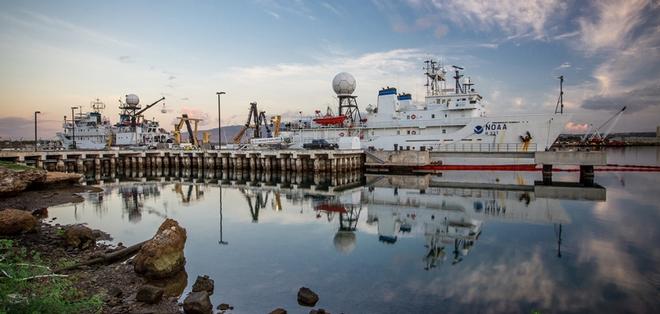10 greatest sightings from deepwater exploration of the Pacific
by NOAA Fisheries on 15 Sep 2017

NOAA Ship Okeanos Explorer in port on Ford Island, Pearl Harbor, Hawaii NOAA Fisheries
Today, the NOAA Ship Okeanos Explorer is embarking on the last leg of NOAA’s three-year mission to explore the deep Pacific Ocean when it heads to the Musicians Seamounts and the Hawaiian Islands.
Starting September 7, you, too, can join the expedition virtually by following the live video streamed by a remotely operated vehicle (ROV) diving down to the seafloor near Musicians Seamounts. Dives will continue through September 29, usually between 2:00 p.m.–12:00 a.m. Eastern, depending on weather and ocean conditions.
As the Okeanos sets out on its final research leg of this mission, we invite you to take a photo and video journey through the 10 greatest sightings – to date – made during NOAA’s CAPSTONE mission, a multiyear effort to collect baseline information to support science and management decisions in and around U.S. marine protected areas in the central and western Pacific.
And now, the Top 10 sightings from NOAA’s CAPSTONE mission:
1. The largest sponge known in the world
On August 12, 2015, the team aboard NOAA Ship Okeanos Explorer observed the largest sponge known in the world, found at a depth of 2,134 meters within the Papah?naumoku?kea Marine National Monument. The sponge was close to 12 feet long by seven feet wide, practically as big as a minivan!
2. A potential new species of octopod
On February 27, 2016, while exploring at depths of over 4,000 meters northeast of Necker Island in the Hawaiian Archipelago, the Okeanos team encountered this ghostlike octopod, which is almost certainly an undescribed species and might not belong to any described genus (that is, a group of related animals or plants that includes many different species).
3. Sighting of a Crossota jellyfish
This stunning jellyfish was seen in the Marianas Trench Marine National Monument on April 24, 2016, while exploring the informally named “Enigma Seamount” at a depth of about 3,700 meters. Scientists identified this hydromedusa as belonging to the genus Crossota. And yes, despite the surreal quality of the footage, it is indeed 100 percent real.
4. The first live sighting of ghost-like fish
This fish, measuring about 10 centimeters long, was seen while exploring a ridge feature at a depth of about 2,500 meters on July 1, 2016. This is the first time that a fish in the family Aphyonidae had ever been seen alive, experts said. We now have the first evidence of where these fish live. Seeing these fish in their natural habitat will help us begin to understand the organism’s life.
5. An underwater vent gushing metal particles
This gushing hydrothermal vent was captured on camera for the first time on May 1, 2016, during the Deepwater Exploration of the Marianas. The 30-meter-high underwater vent was spewing high-temperature liquid thick with metal particulates. The area around it is home to exotic species including Chorocaris shrimp, Munidopsis squat lobsters, Austinograea crabs, limpets, mussels and snails.
6. A first look at historic Japanese mini-submarines near Pearl Harbor, Hawaii
On December 7, 2016, the 75th anniversary of the attack on Pearl Harbor, the NOAA Ship Okeanos Explorer team, in partnership with the NOAA Office of National Marine Sanctuaries, explored a Japanese mini submarine five miles from the entrance to Pearl Harbor. Navy destroyer USS Ward sunk the sub on the morning of December 7, 1941, 90 minutes before Japanese military planes bombed the harbor. The sinking of the sub marked America’s entry into World War II in the Pacific.
7. Maps of hundreds of thousands of square kilometers of seafloor
Mapping the seafloor has revealed features, such as seamounts, that we did not know existed. The mapping done in the last three years is one of the most important datasets the mission has produced; it’s information that is valuable to science, resource management and national security. Mapping is a foundational step in all ocean exploration. NOAA Ship Okeanos Explorer is equipped with four types of mapping sonars that allow us to gather high-resolution bathymetric (depth measurements of the ocean floor) and other data from unexplored areas.
8. A fierce battle between a shrimp and a dragonfish
On March 27, 2017, while diving at a depth of around 998 meters at Ufiata Seamount within the Tokelau Seamount Chain, scientists witnessed a fierce battle between a caridean shrimp (Heterocarpus) and a type of midwater dragonfish. Deep-sea shrimp have typically been observed as scavengers – not hunters – and scientists wonder how this shrimp was able to capture the fish.
9. A rare sighting of brittle stars capturing a swimming squid
On May 5, 2017, scientists observed a very rare occurrence of a brittle star, of the family Ophiotrichidae, capturing and eating moving prey: a small squid in the genus Abralia. Most ophiuroids have been observed either scavenging or feeding by some other passive means, such as filter feeding, usually by suspending their arms in the water current. This particular encounter was the first time this behavior had been seen since 1998.
10. A fascinating journey through a new frontier
On May 6, 2017, while operating in the Jarvis Unit of the Pacific Remote Islands Marine National Monument, the Okeanos Explorer team conducted a series of midwater surveys from 1,400 to 300 meters. At about 1,400 meters depth, we recorded this pelagic holothurian, or deep-sea swimming cucumber. It differs from other sea cucumbers because it resembles a jellyfish. Midwater surveys increase our knowledge about the largest, yet one of the least understood, natural communities on Earth, the water column – a new frontier for exploration.
If you want to link to this article then please use this URL: www.sailworldcruising.com/157280